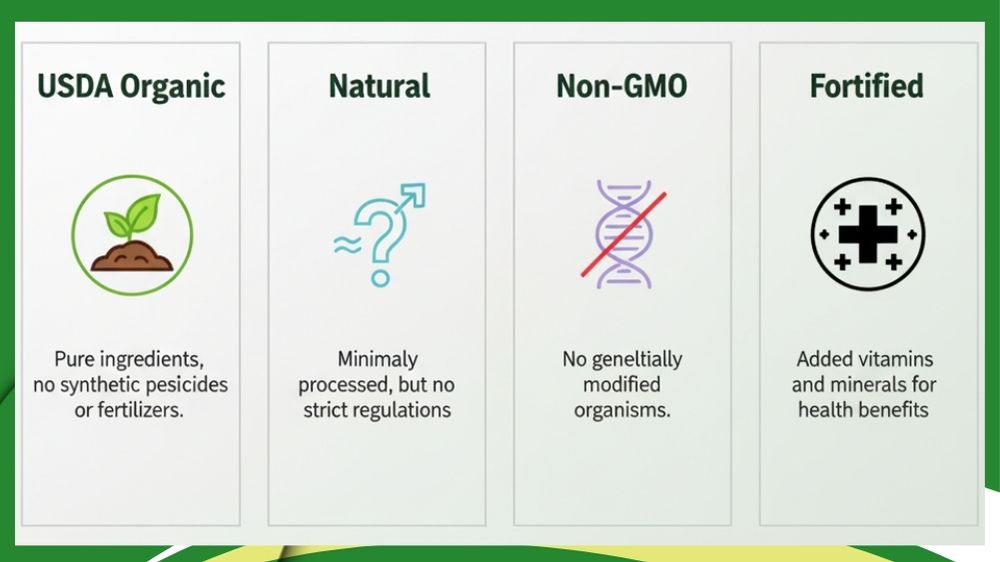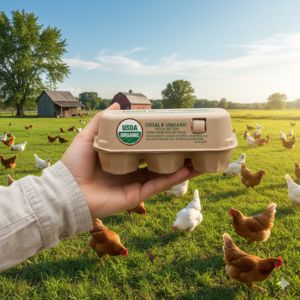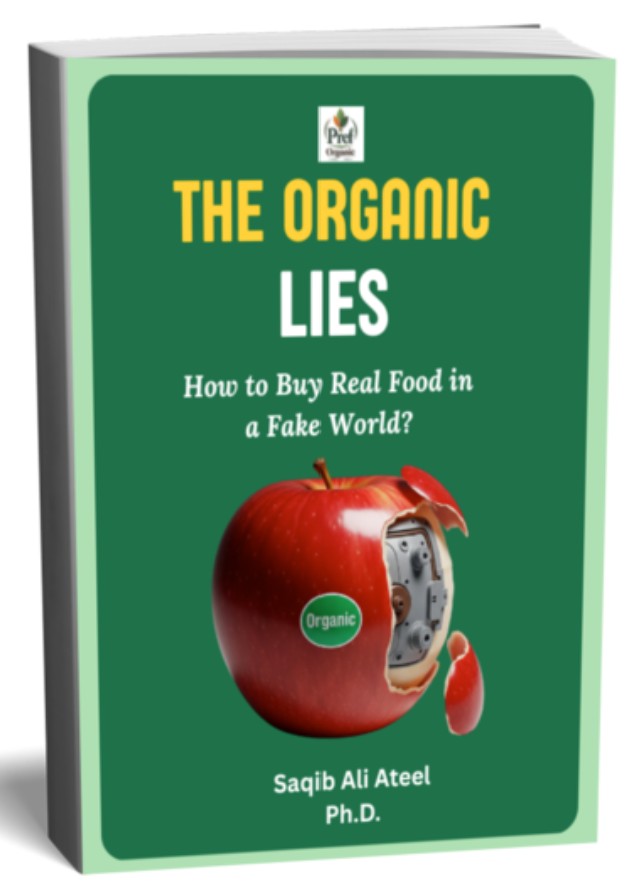A PhD Farmer's Guide to Decoding Organic Food Label
Requirements

The organic food label requirements relate to complex, intricate, and scientific information that you often worry about while standing in a grocery aisle, phone in hand, feeling a rising sense of anxiety. You're facing a "wall of words"—labels shouting "Organic," "Natural," "Non-GMO," "Fortified"—and all you want is to make sense and a simple, confident choice for your family.
You’re skeptical of marketing hype and want a straight answer to a simple question: "What do all these labels really mean?"
I understand that feeling completely. I've spent my life in the food system, from the soil of my family's farm to my PhD research, and now to my own home garden where I grow food for my kids. My promise to you is to be your "Scholar-Farmer-Friend"—to be the calm, clear voice that cuts through the noise. We will transform that plethora of scientific terminologies and sift through the marketing hype to develop a simple map, so you can navigate any supermarket with the peace of mind you deserve.
Let's decode these labels together.
What Will You Discover on This Page?
Here’s a quick look at the clarity you’re about to gain. This is your complete supermarket survival guide.
- 🧠 The 3-Second Label Test: Learn to instantly spot the most trustworthy seal in the entire grocery store, backed by law and rigorous inspections.
- 🛡️ Organic vs. The "Impostors": Get a simple, side-by-side comparison that finally clears up the confusion between "USDA Organic," "Natural," "Non-GMO," and "Fortified."
- 🌱 From Label to Land: Discover the "insider's perspective" on why some labels are a promise of healthy soil and sustainable farming, while others are often just empty marketing.
- 💪 Your Confident Action Plan: Leave this page with a simple, actionable mental checklist to make the best choices for your family, every time you shop.
The Organic Hierarchy: Decoding the USDA Organic Food
Label 🧠
The most important label to understand is the USDA organic food label. It's not a marketing claim; it's a legal guarantee backed by a strict rulebook. But not all organic labels are created equal. The organic food label requirements define three distinct tiers you need to know.
1. The "100% Organic" Label
- What It Means: Every single ingredient in the product (excluding salt and water) is certified organic. The processing aids used must also be organic.
- What to Look For: You will see the phrase 100 organic food label and it can display the official green or black USDA Organic seal.
- The Farmer's Take: This is the gold standard, most often found on single-ingredient foods like fresh produce, eggs, or a bag of organic oats. It's a promise of absolute purity.
2. The "Organic" Label (The Most Common Seal)
- What It Means: The product contains a minimum of 95% certified organic ingredients. The remaining 5% of non-organic ingredients must be from a list of approved substances.
- What to Look For: This is where you'll most often see the iconic green USDA organic food label.
- The Farmer's Take: This is your most powerful and reliable signal of trust in the grocery store. For complex products like pasta sauce, bread, or cereal, this seal guarantees that the core of what you're buying was grown and processed according to the strict organic rulebook.
3. The "Made with Organic Ingredients" Label
- What It Means: The product contains at least 70% certified organic ingredients.
- What to Look For: This product cannot use the USDA Organic seal. It can only list up to three specific organic ingredients on the front of the package (e.g., "Made with Organic Oats").
- The Farmer's Take: This is a "good, but not great" sign. It shows the manufacturer is making an effort, but it also means that up to 30% of the product falls outside the strict organic standards. It's a step in the right direction, but it doesn't carry the same weight as the official seal.
Organic vs. The "Impostors": A PhD Farmer's
Side-by-Side Comparison 🛡️
Now that you've mastered the organic labels, let's put them in context. This is the "basket of clarity" that will help you navigate the rest of the aisle.

This image gives you the quick, 3-second test you can use in the aisle. It's your starting point for clarity.
But I want to share a little deeper story. Your trust is everything, and it's earned in the details. In the table below, we will put each of these labels under the microscope. We'll compare what they promise to what they actually guarantee, and I'll give you my honest farmer's verdict on each one. This is how we move from a quick glance to true confidence.
| Label | The Promise (What it Claims) | The Reality (What it Guarantees) | The Farmer's Verdict |
|---|---|---|---|
| USDA Organic | A product grown and processed according to strict federal standards for soil health, pest control, and animal welfare. | A Legally-Backed System. Guarantees no GMOs, no routine synthetic pesticides, and adherence to a long list of sustainable practices, verified by an annual inspection. | ✅ Your Gold Standard. This is the only label on this list that connects the product back to the health of the soil and the farm's ecosystem. It's a promise you can trust. |
| "Natural" | Wholesome, simple, and from nature. | Almost Nothing. The term "natural" is not regulated by the USDA for most foods. It generally means nothing artificial has been added, but it makes no promises about how the ingredients were grown (e.g., use of pesticides, GMOs). | ⚠️ A Marketing Term, Not a Standard. This label is often used to create a "health halo" around a product. Ignore it and look for the USDA Organic seal instead. |
| Non-GMO Project Verified | The product does not contain genetically modified organisms. | A Single-Issue Guarantee. This seal is excellent for its specific purpose—verifying the absence of GMOs. | 👍 Good, but Incomplete. All USDA Organic products are inherently non-GMO, but not all non-GMO products are organic. This label doesn't tell you anything about pesticide use or farming practices. |
| Fortified / Enriched | Extra vitamins and minerals have been added to the food. | A Nutritional "Add-On." It guarantees that specific nutrients have been added, often to replace those lost during processing. | 🧠 A Different Philosophy. This is a tool of industrial food science, not a farming practice. It can be beneficial, but it doesn't tell you anything about how the underlying food was grown. |
Organic vs. Fortified: A Deeper Dive
These two labels represent two fundamentally different approaches to health.
- Organic is a systems-based approach. The philosophy is that by nurturing healthy, living soil and a balanced farm ecosystem, the plant itself will be more resilient and nutrient-dense. It's about building health from the ground up.
- Fortification is an intervention-based approach. It often starts with a processed food (like white flour or refined cereal) and adds back specific, isolated vitamins and minerals that were lost.
Think of building a house. The organic approach is like building with strong, high-quality, natural materials from the very beginning. The fortification approach is like building with cheaper materials and then coming back later to patch the weak spots. Both can result in a standing house, but they are built on entirely different principles.
Neither is inherently "bad," but they are not the same. As a cautious food selector, it's crucial to understand this difference.
To learn more about this important distinction, you can read deep-dive at Fortified vs. Organic: What's the Difference and Which is Better for Your Family?
Your Action Plan: The 3-Second Label Test 💪

You're in the aisle. You're busy. You need a mental shortcut. Here it is.
When you pick up a package, your eyes should do a quick scan in this order:
1. Look for the Seal: Scan for the green or black USDA organic food label. If you see it, you have a powerful, trustworthy signal of quality.
2. Read the Ingredients: Is the list short and full of recognizable, whole-food ingredients? Or is it long and full of things you can't pronounce?
3. Check the Sugar: Look at the "Added Sugars" line on the nutrition panel. This number tells you a lot about the product's true intention.
In just a few seconds, this test gives you a vast amount of information and empowers you to make a confident choice every time.
Your Journey to Confidence is Just Beginning
You came here feeling overwhelmed by the organic food label requirements, and I hope you now feel a sense of calm, confident empowerment. You don't need to be a scientist to shop with confidence. You need a clear map and a trusted guide.
This page is your map. Use it as your central hub. When you're ready to go deeper, explore our dedicated guides on each of these topics. You have the tools. You know. You’ve got this.
USDA Guidelines for Organic Food: 4 Promises Behind the Seal
What Makes Organic Food Organic: A Complete Guide to USDA Standards
Is CRISPR Food Allowed in Organic?
For the Curious Mind: Dive Deeper with These Trusted
Sources
For those of you who want to go straight to the source, these official resources are the best next step.
1. USDA: Organic 101
o This is the official source from the United States Department of Agriculture. This page provides a clear, user-friendly overview of what "organic" means, how it's regulated, and the standards behind the seal. It's the perfect place to verify the facts we've discussed.
2. The National Organic Program Handbook
o For the truly dedicated researcher, this is the official rulebook. The NOP Handbook provides the detailed guidance, instructions, and policies that certifiers and farmers must follow. It's dense, but it is the ultimate source of truth for all organic food label requirements.
3. FDA: Food Labeling & Nutrition
o This is the FDA's central hub for all food labeling topics outside of the organic program, including claims like "natural" and the rules for nutrition facts. It's an excellent resource for understanding the broader context of what you see on a food package.
